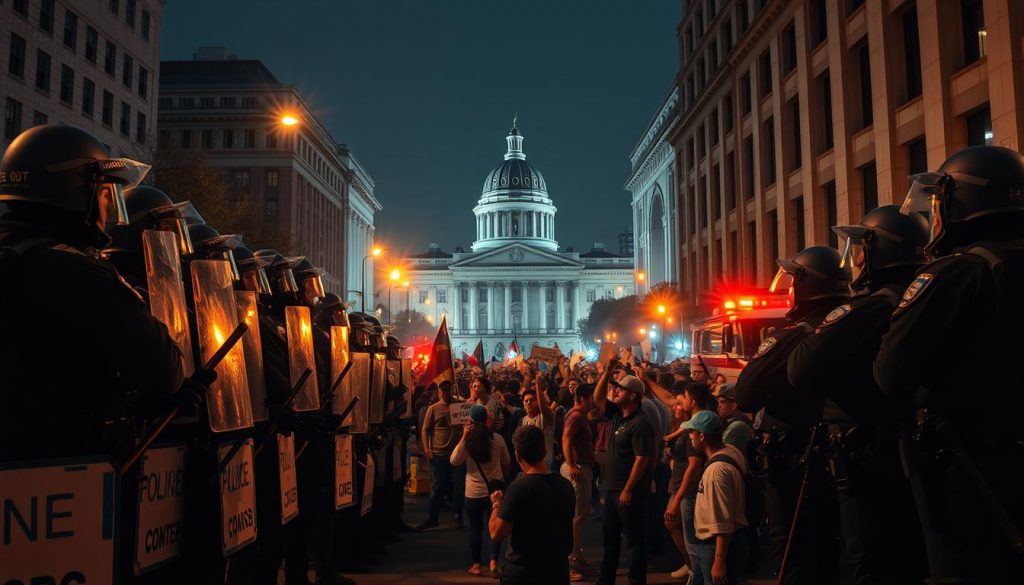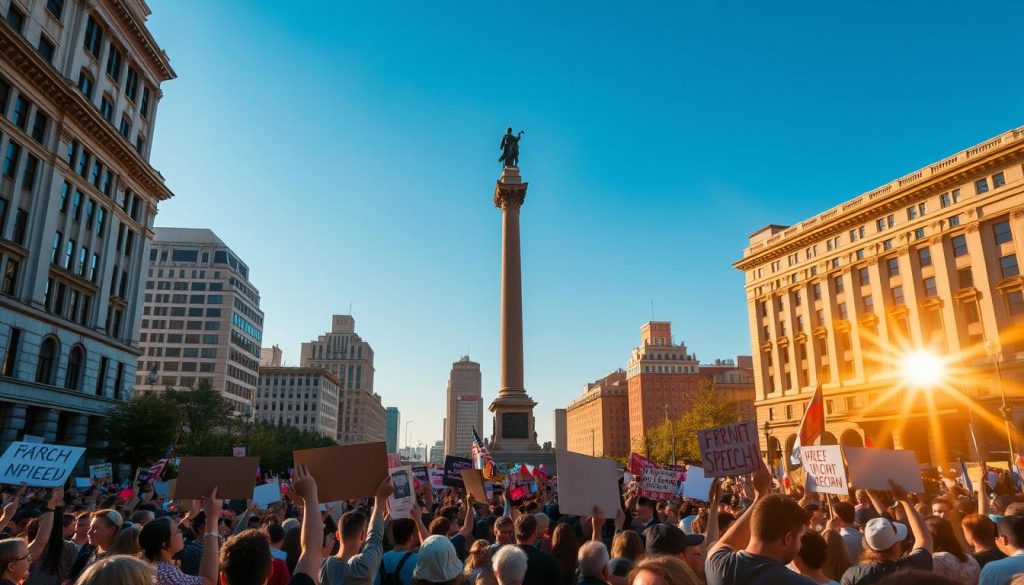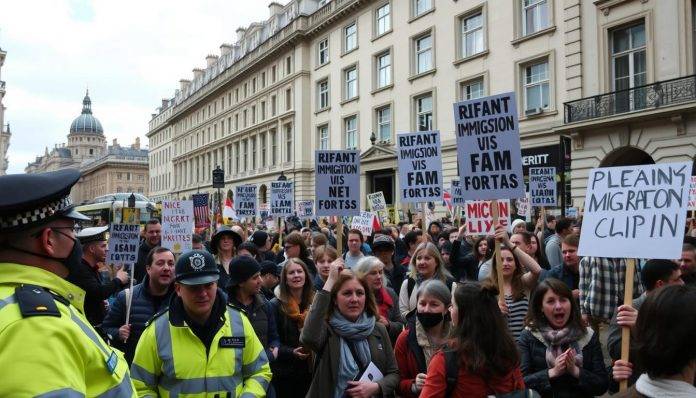How can a single march shift the tone of national debate overnight? An estimated 110,000–150,000 people gathered for the “Unite the Kingdom” march, a turnout that far exceeded forecasts and stretched from Big Ben across the Thames towards Waterloo.
The rally, billed as a defence of free speech and national pride, drew high-profile amplification from a video address by Elon Musk and a speech by Tommy Robinson. Police described “unacceptable violence,” reporting at least 26 injured officers and more than 25 arrests as officers reinforced cordons and used riot shields to keep rival groups apart.
Many attendees said they felt ignored by politicians and worried about massive, uncontrolled migration, while counter protesters demanded refuge and inclusion. The event mixed patriotic symbolism with inflammatory chants, raising fears that violence and polarising rhetoric could erode democratic norms.
This piece will examine who spoke, how the day was framed, street-level scenes, the policing response, and the wider political stakes, drawing on contemporary reporting such as this coverage of the march.
Key Takeaways
- Between 110,000 and 150,000 attended the “Unite the Kingdom” march, substantially above expectations.
- Speakers and amplifiers, including Tommy Robinson and a video from Elon Musk, raised the event’s profile.
- Police reported serious clashes, at least 26 officers injured, and multiple arrests.
- Supporters framed the day around free speech and migration concerns; critics warned of polarisation.
- The scale was large but remained smaller than a 300,000‑strong pro‑Palestinian march in November 2023.
- Violence risked undermining democratic norms even as the right to protest was exercised.
At a glance: a massive turnout, violent clashes, and injured officers
A crowd far larger than organisers predicted filled key central streets, turning a planned march into a major national event. Police estimated attendance at between 110,000 and 150,000, dwarfing forecasts and creating one of the largest right‑wing demonstrations in modern Britain.
Clashes left at least 26 officers injured and prompted around 25 arrests on the day. Officers used riot shields and protective kit as some supporters tried to push through cordons.
- About 1,600 police were deployed to manage the route from Big Ben across the Thames towards Waterloo.
- Counterprotesters from Stand Up To Racism numbered roughly 5,000 and carried placards urging “smash far right” and “refugees welcome”.
- Senior officials called the violence “unacceptable” and said footage would be used to identify more suspects.
“Anyone who attacks police will face the full force of the law.”
Organisers framed the day as free speech, but the escalation underlined how quickly demonstrations can shift from expression to confrontation. The turnout did not match the roughly 300,000 people at a larger November march, yet it still signalled concerns about a rapidly increasing erosion of public trust and the increasing erosion of Britain, voiced by many attendees.
London Anti-Immigration Protest: What Happened, Why It Matters
A mix of domestic organisers and foreign figures used the platform to press a shared grievance about immigration.
Key speakers and their messages
Tommy Robinson—whose real name is Stephen—addressed the crowd. The activist Tommy Robinson (real name Stephen Yaxley-Lennon) framed the rally as patriotic. He claimed migrants enjoyed greater protections in the migrants’ rights court than “the people that built this nation.”
Elon Musk appeared by video, praising “something beautiful” about British identity and warning of “massive uncontrolled migration.” French politician Eric Zemmour repeated the great replacement line, saying European people risked being “colonised” by those coming south and by muslim culture.
Street scenes and counter‑responses
On the streets a sea of flags and placards read “stop the boats” and “send them home”. Chants of “we want country back” met counterchants of “smash the far right” from thousands organised by Stand Up To Racism. MPs including Zarah Sultana and Diane Abbott joined the counterprotest.
“Several speakers led a moment of silence for Charlie Kirk, followed by a bagpiper playing Amazing Grace.”
| Aspect | Message from stage | Public reaction |
|---|---|---|
| Leadership | Tommy Robinson; video from Elon Musk; speeches by Eric Zemmour | Large turnout; heightened media attention |
| Core framing | Described as a “free speech” and patriotic mobilisation | Supporters claimed to feel ignored by politicians |
| Main claims | Migration out of control; references to the great replacement | Counterprotesters rejected the rhetoric; tens of thousands opposed it |
Policing, public order, and accountability
A large policing operation became the focus as attempts to breach barriers escalated into violence. Officers worked to keep the main march and counter‑demonstrations apart while evidence teams recorded events.

Injuries and disorder
The Met recorded at least 26 officers injured during efforts to prevent breaches of cordons. Reported injuries included broken teeth, a possible broken nose, concussion, a prolapsed disc and a head injury.
Arrests and accountability
At least 25 arrests were made on the day. Assistant Commissioner Matt Twist said extensive footage from body‑worn cameras, drones and social media would be reviewed to identify more suspects.
- About 1,600 officers were deployed to separate rival groups and secure junctions.
- Senior police called the violence “unacceptable”; the Home Secretary pledged legal consequences for attacks on officers.
- Police noted the majority had lawful intent, but a determined minority caused disorder that required enforcement.
Officials also linked the tensions to earlier disturbances outside hotels housing asylum seekers after a conviction for sexually assaulting 14-year girl, underlining wider strains. Community groups such as stand racism said some members were targeted during clashes.
“The force will use all available evidence to hold those responsible to account.”
Balancing the right to protest with public safety is central. Transparency in the investigation will shape how trust responds to the increasing erosion of civic calm and to claims raised in forums like the migrants rights court. The ceremony of free speech cannot excuse violence, nor allow scenes that others remember as a moment to see happening destruction.
Context and stakes: free speech, democratic rights, and public concern over immigration
Public anxiety about migration and governance framed the march as more than a street event. Organisers argued the gathering was a lawful exercise in debate and a call for attention to policy.

Democratic expression
The right to peaceful assembly covers contentious topics, including migration. Demonstrations that stay within the law allow citizens to press grievances and influence debate.
Frustration with government
Many attendees said they felt ignored and feared Britain’s massive uncontrolled flows. For them, the march was a way to force politicians to respond.
The cons of protesting
When demonstrations turn violent, they damage trust and polarise communities. Divisive rhetoric that invokes the process great replacement or references to European people risks normalising exclusion.
Political landscape
The event sits amid rising support for parties like Reform UK and increased far‑right mobilisation in parts of the electorate. It was large by recent right‑wing mobilisation standards but smaller than the 300,000 crowd at the November march.
| Issue | Claim | Consequence |
|---|---|---|
| Rights | Calls for free speech and lawful assembly | Allows public airing of grievances if peaceful |
| Public concern | Fears of britain massive uncontrolled migration and local strains | Political pressure and policy debate |
| Risks | Use of exclusionary narratives (e.g. process great replacement) | Community division and erosion of civic norms |
| Flashpoints | Incidents outside hotels used to house asylum seekers | Local disputes can fuel national mobilisation |
“Separating verifiable concerns from conspiratorial claims is critical to policy that upholds rights and social cohesion.”
Conclusion: London Anti-Immigration Protest: What Happened, Why It Matters
A single mobilisation exposed tensions between lawful dissent, public safety, and political accountability. The “unite kingdom” march — joined by speakers including Tommy Robinson, and a video from Elon Musk, and featuring figures such as eric zemmour — drew a large crowd and intense scrutiny.
The turnout, estimated at up to 150,000, and reports of at least 26 injured officers and around 25 arrests show the costs when disorder follows a demonstration. Countergroups, including Stand Up To Racism, amplified opposing voices on the day.
Moving forward, authorities must balance the right to protest with proportionate policing, insist on responsible rhetoric, and pursue evidence‑based policy to address concerns over massive uncontrolled migration and the increasing erosion of Britain, as fears are voiced by many.
For more Economic Indicators articles, please follow the link


